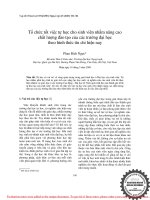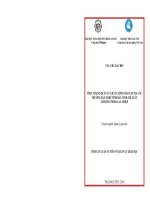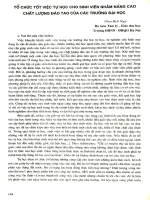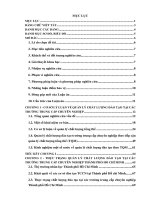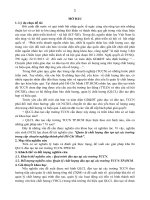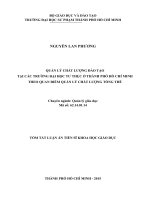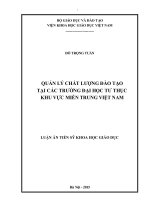Đánh giá việc quản lý chất lượng đào tạo của các trường đại học trực thuộc bộ công thương
Bạn đang xem bản rút gọn của tài liệu. Xem và tải ngay bản đầy đủ của tài liệu tại đây (1.32 MB, 83 trang )
THAI NGUYEN UNIVERSITY SOUTHERN LUZON STATE UNIVERSITY
Socialist Republic of Vietnam Republic of the Philippines
ASSESSMENT OF THE QUALITY MANAGEMENT TRAININGS OF
UNIVERSITIES UNDER THE MINISTRY OF INDUSTRY AND TRADE
A Dissertation
Presented to
the Faculty of Graduate School
Southern Luzon State University
Lucban, Quezon Philippines
In Partial Fulfillment
of the Requirements for the Degree
Doctor of Philosophy
in Educational Management
by
BUI QUANG CHUYEN
(FABLE)
April 2014
2
CONTENTS
No
Contents
Page
Chapter I – INTRODUCTION
4
Background of the Study
7
Objectives of the study
8
Significance of the study
9
Scope and limitation of the study
10
Definitions of Terms
10
Chapter II – REVIEW OF LITERATURE AND STUDIES
14
2.1
Management
14
2.2
Quality management and management of training quality
15
2.3
Education management
16
2.4
Quality of training
17
2.5
Quality assessment
17
2.6
Quality assessment criterions of ASEAN University Network
(ANU)
19
2.7
Quality assessment criterions of Universities in Vietnam
20
Research Paradigm
21
Chapter III – RESEACH METHODOLOGY
22
3.1
Locale of the Study
22
3.2
Research Design
23
3.3
Population and Sampling
23
3.4
Research Instrumentation
24
3.5
Data Gathering Procedure
24
3.6
Statistical treatment of the data
24
3.7
Questionnaire and Information collection method
24
Ranking method
26
Statistical table method
27
3
Chapter IV – RESULTS AND DISCUSSIONS
28
4.1
Result of the assessment of the quality management training of
the universities under MOIT
28
4.2
Solution to develop and enhance program based on the finding
41
4.3
Evaluate the enhancement program by experts on the field
53
4.4
Discussions
54
Chapter V – SUMMARY, FINDINGS, CONCLUSIONS
AND RECOMMENDATIONS
55
5.1
Summary
55
5.2
Findings
55
5.3
Conclusion
55
5.4
Recommendations
56
REFERENCES
60
A. Books
60
B. Periodical, Journal and Magazine
60
C. Unpublished Materials
61
D. Electronic References
61
APPENDICES A
62
APPENDICES B
76
4
Chapter I
INTRODUCTION
In past years, Vietnam’s education and training sector has achieved
significant accomplishments considering the size and quality of training which
shows an increasing demand for technical labor force by economic sector,
manufacturing and services. The trainings conducted at university levels had
been gradually strengthened that resulted to significant management changes.
Quality training is the top concern of the whole society but it still exists
many problems which need to be solved particularly in the scope of state
management and school management. Training facilities have been directly
created and take the responsibility for the quality of training. However, higher
education sector also reveals many shortcomings and weaknesses, such as: the
quality of education is generally low which is not responsive to the demands of
social and economic development of the country; the management mechanism
of State for higher education system and the management of universities and
colleges is unreasonably prolonged and does not create a strong motivation to
develop the creative capacity and responsibility among the faculty members,
managers and students. It is also a fact that social and potential foreign
investment for the development of higher education has not been promoted
effectively.
In the international context, the world is moving toward industrial and
automatic revolution, taken as a dynamic knowledge development. Level of
innovation and the application of knowledge decide the level of development of
each country. The development of science and technology has drastically
changed the content and methods of education in schools, and requires higher
education to provide highly qualified human resources for society.
In domestic context, in terms of opportunities, after nearly 30 years of
transition, the country enters a period of strong growth with the new position
5
and appearance. Vietnam’s economy is more improved, national security is
well-maintained. Economic structure continues to shift toward strengthening
industrial and service sectors. The living standard of community is markedly
improved. Vietnam is actively involved in the process of international
integration with high economic growth rate and a stable political environment.
By actively integrating into international economics and joined the World Trade
Organization (WTO) in 2007, it has created more favorable conditions for
socio-economic development process of Vietnam.
However, despite the significant growth, the Vietnam’s economy is still
suffering from low-income economy. Indicators of infrastructure, human
development is still lower than many countries in the world. Labor productivity
is low; production is still mainly based on outdated technology, products as raw
materials, high cost, low value added. The economic structure has shifted but
still slow: the ratio of services and industry in GDP is low. Economic
infrastructure and social development does not meet the requirements. Quality
management of the State for many areas of socio-economic, health and
education sectors are limited. International cooperation is extended to facilitate
investment of other countries, international organizations and foreign
enterprises, increase the demand for labor recruitment through training, creating
opportunities for education development.
Global integration process in the education creates favorable
opportunities for Vietnam to quickly access to new trends, new knowledge, the
modern model of education, taking advantage of international experience to
develop and narrow the development gap between Vietnam and other countries.
The contribution of the state's resources and people for the development of
education is increasingly enhanced. Many economic sectors are willing to
contribute to education revolution in Vietnam.
The needs of learning at university level of Vietnamese (especially
young people between the ages of 18-45) are enormous. The needs of highly
6
qualified, professional skills, be able to meet the requirements of the operation
and exploitation of advanced technological devices labor force are also high
Therefore, university should have a appropriate strategy to achieve both
quantity and quality of training.
In terms of challenges, with the strong development of the scientific
revolution, the technology in the world can make the economic and knowledge
gap between Vietnam and other countries increasingly larger, Vietnam is at risk
of lagging further. Education management capacity of Vietnam is weak, the
lack of appropriate policies and measures to guide and monitor the educational
institutions with foreign elements.
Requirements of economic development in the coming years request not
only the number but also request high quality of human resources. With the aim
of continuing to grow over the threshold of the low-income country, Vietnam
need to restructure the economy, develop value-added and high technology
products and services. To do this contents, it requires Vietnam to have sufficient
qualified manpower engineering and technology. Currently, Vietnam has more
than 63% of working-age population, but the level of the labor force is still low
compared to many countries in the region, both in knowledge and professional
skills. The country lacks highly qualified labor force in various fields, especially
the field of electric, electronic and information technology. Etc. The structure of
the workforce through training (university / high school / vocational training) is
not reasonable. The demand of trained labor force is increasing in both quantity
and quality it also puts more pressure for university education.
By 2020, Vietnam will basically become a modern industrial country
following the university requirements of the Ministry to train and provide
technical qualified human resources for heavy industry (including: the
engineering; metallurgy; exploitation, processing of minerals); light industry
(including: textiles; footwear; food processing; wine, beer and beverage
production. etc.); energy (includes: electricity; electronics; petroleum);
7
economics, business administration,. Etc The demand of Industrial and Trade
sector on high quality labor force is huge, but the universities do not meet the
requirements of the quantity and quality of training. Therefore, this dissertation
will research and recommend solutions on quality training of the universities
under the MOIT.
In fact in Vietnam, many graduates but cannot find jobs or they have to
do jobs differ from subjects that they have been trained. One of the reasons is
the quality of education; especially the quality of training of human resources
cannot meet the employer’s desire and expectations as well as requirements of
industrialization, modernization and international integration objectives. Overall,
the quality of graduates is limited, professional practice skills, information
technology skills language ability and social activities of students did not meet
the requirements of the employers.
BACKGROUND OF THE STUDY
At present, Ministry of Industry and Trade has 8 universities. They were
established on the basic of the upgrade from college and are derived from the
secondary schools, professional training mainly engineering, technology and
economic management, direct service for businesses.
In fact, through testing, evaluation, the management of the quality of
university education in universities under MOIT as follows:
1 . Advantages:
Each university has built and identified goals and mission for itself. They
gradually change teaching and learning methods, infrastructure investment and
training facilities, consolidate construction teachers develop proficiency
standards, cooperation in scientific research and technology transfer.
2 . Constraints and disadvantages :
Every year, there is not a realistic assessment and report on the quality of
education in general and higher education system in particular since there is no
8
standard output of the university, not quantitative standards of teachers,
programmes , facilities .etc.
- There is no correct solution to implement the identified targets. Training
programs do not fully develop in the field of study curriculum prescribed by the
Ministry of Education and Training; Teaching and learning activities are not
effective so the graduates do not meet the requirements of the employers,
majority of producers must retrain knowledge, practical skills; The management
of faculty, administrators and staff does not ensure the standards and
qualifications in accordance with the Charter of the University. Besides, it’s
also lack of policies and working conditions to encourage scientific research of
students and lecturers.etc.
- Every year, the report does not have a realistic assessment of the
quality of education in general and university education system in particular.
From the Central Government (Ministry of Education and Training, the
Ministry of Industry and Trade) to the base of university education is no agency
in charge of quality management training;
For these reasons, I choose the research title: “Assessment of the
management quality trainings of universities under the MOIT” for my PhD
dissertation with the hope that I can play my contribution to improve contents
above to enhance the management quality training of universities under the
MOIT.
OBJECTIVES OF THE STUDY
This study focused on the assessment of the quality management
trainings of the universities under the MOIT. Specifically, it sought answer to
the following objectives:
1. Assess the quality management trainings of the universities under the
MOIT in terms of :
1.1. Mission and goal;
9
1.2. Education program;
1.3. Training activities;
1.4. Management of staff and faculty;
1.5. Scientific research application development and technology
transfer;
1.6. Learning equipment and facilities.
2. Develop an enhancement program based from the finding.
3. Evaluate the enhancement program by experts on the field.
SIGNIFICANCE OF THE STUDY
This study will be of significance to the following:
Through this research, the managers shall be assisted in assessment of the
quality management trainings of the universities and at the same time will serve
as the legal basis for assessment of the quality of training, based on the devised
policies.
University leaders:
From this research, the university leaders will be able to build and design
a mission of the university management in providing quality management
training. Hence, the application of the solution will improve the quality of
education in universities.
Faculties
This study will help teachers understand the role and responsibilities in
improving of assessment the quality management training. For them to know
that good quality training, along with other measures, requires good teaching
staff, the ability to guide and equipped with the proper knowledge and skills for
the advancement of students.
Students
Students will also directly benefit from this study. The investment of
money, effort, time - time to get the quality of knowledge, professional skills in
10
their learning and research at the university. Upon completion, graduate
students will apply the knowledge learned to practical production-business.
Head of Business enterprise production
This study will help businesses to select qualified human resources
(knowledge, skills, and attitudes) in their recruitment strategy. At the same time,
business sectors shall be able to have a clear idea on their roles and
responsibilities in financial aspects/contributions, as well as to facilitate the
location and environment for students for domestic practice, thus, improving the
quality of training of students.
SCOPE AND LIMITATIONS OF THE STUDY
This study focused on the assessment of the quality management
trainings of the universities under the MOIT at Vietnam. There were 15
education managers, 10 faculties and 5 students for each 8 universities with a
total of 240 respondents involved in the study.
The instrument used in this study was the questionnaire to assess the
quality management trainings of the universities under the MOIT. The variables
used for the assessment were the Mission and goal, education program, training
activities, management of staff and faculty, scientific research application
development and technology transfer, learning equipment and facilities.
DEFINITION OF TERMS
Assessment:
Assessment can be defined as a general term Furniture embraces all
methods used to judge the performance of a group, an organization or an
individual. Evaluation is a review, critique, valuation.
Management:
The way of organizing control, impact of management objects subject to
management in order to effectively achieve objectives set by the organization.
The form of the main functions of management: planning, organizing,
leading and directing or check.
11
Education is a system of complex operations, therefore need to be closely
managed.
Management education is implemented in the field of management
education. Management education is managed mainly the younger generation
education, school education, education in the national education system.
Management education is to implement and monitor policies for education and
training on a national level, regional, and local basis.
Quality management training:
Management training is quality management is responsible for ensuring
the results of training activities to achieve educational goals. Quality
management training is done through the process of evaluating the results of the
education and training of students, student performance evaluation of schools
and educational institutions.
Quality management training was conducted in a planned, organized,
based on different criteria.
The method of quality management training including group assessment
methods and traditional reporting, the test methods associated with information
systems management education .
Management quality of higher education is an activity aimed at ensuring
the quality of training of the university. Quality Management System
universities often implement the following activities:
- Develop criteria and process documentation and tools to evaluate the
quality of the university.
- Monitor quality assurance and self-assessment activities.
- Organization of the external evaluation of the quality of individual
generalized every college or training programs, the evaluation report.
- Dissemination of good practices to ensure the quality of the university,
the teaching methods, examination methods.
Mission and goal:
12
The Mission is the content and mission statement to work towards
Objectives. The goal is to achieve the targets. Mission and goal are target
strategies, goals to be achieved.
The goal is an indication that the subject request (the school, the learners)
should be achieved after a process of training and learning. These requirements
are presented as a model of how to take into account the standard of education
and training systems, a large set of characteristics predicted or sustainable
change will occur in an important group of all possible after a learning process .
Mission and the overall objectives of the university is to develop scale
(numbers, trades training) coupled with quality assurance training to develop
comprehensive human, moral, intellectual, health, aesthetics and career.
Education program:
Education program is to equip the knowledge and skills for learners.
The training program is used to identify goals, objectives, requirements,
knowledge and skills, the overall structure of the subject, practice plan, every
year high ratio between subjects (modules), between theory and practice,
prescribed methods , methods , means , facilities , certificates, and diplomas of
education and training institutions.
Training programs by professional bodies or ministerial drafted by the
institutions (universities, colleges ) itself, but must be prepared by authority to
approve and allow out.
The training program is the basic for planning staff, curriculum
development, instructional materials, cost estimating, construction of
facilities.etc as well as a basic for monitoring, control, inspect, evaluate and
approve training diploma.
Training Activities:
Training activities are teaching and learning performance in schools to a
new direction to achieve goals.
13
In a narrow sense, the training activity is activities of teachers (collective
and individual) to form worldview, ethics, and foster knowledge, skills and
physical development through measures to effect on emotions and lifestyles of
students. .
Management of staff and faculty:
Management of staff and faculty are managed in quantity, content and
tasks of the staff and teachers to undertake scientific research application
development and technology transfer.
Scientific research and technology transfer activities of the staff, teachers
and students - students in research and contributions to science, valuable
practical applications to solve economic development - the local society and the
country. The activity of scientific research and technological development of
the university must be associated with training associated with scientific
research institutes, universities and other businesses. The results of scientific
activities and technological contributions to the development of the resources.
Learning equipment and facilities:
Learning equipments and facilities is enable teachers to do his / her work
very well and help the learners to learn effectively. Equipments and facilities
also include school building classrooms, assembly halls, libraries, laboratories,
workshops materials and information technology are sufficient.
Equipment and facilities support teaching and learning for training and
research, be sure to use quality and efficient service to meet the requirements of
teaching and learning.
Enhancement program:
Enhancement program is strengthening / making something better of
program which is still limited.
14
Chapter II
REVIEW OF LITERATURE AND STUDIES
1. Concept management
Management is the process of planning, implementation, management and
inspection and assessment of the work of the members of a system unit and the
use of appropriate resources to achieve the intended purpose.
Figure 1: The content of the management process
Functions of Managers
Managers just don't go out and haphazardly perform their responsibilities.
Good managers discover how to master four basic functions: planning,
organizing, leading, and controlling.
Planning: This step involves mapping out exactly how to achieve a
particular goal. For example: the organization's goal is to improve company
sales. Firstly, the manager needs to decide which steps are necessary to
accomplish that goal. These steps may include increase advertising, inventory,
and sales staff. These essential steps are developed into a plan. When the plan is
in place, the manager can follow it to accomplish the goal of improving
company sales.
Organizing: After a plan is in place, a manager needs to organize her team
and materials according to her plan. Assigning work and granting authority are
two important elements of organizing.
Planning
Organization
Checking and
Assessment
Leadership
15
Leading: A manager needs to do more than only planning, organizing her
team to achieve a goal. She must also lead the team. Leading involves
motivating, communicating, guiding, and encouraging. It requires the manager
to coach, assist, and solve problems with employees.
Controlling: After other elements are in place, a manager's job is not
finished. He needs to continue to check results against goals and take any
essential corrective actions to make sure that his area's plans remain on track.
All managers at all levels of every organization perform these
functions, but the amount of time he spends on each one depends on both the
level of management and the specific organization.
2. Quality management and Management of training quality
- Quality management is the process of designing criteria and maintaining
ones for training products reaching the defined standards.
Quality
Level
Improvement
Overall Quality
Management
Quality
Assurance Prevention
Quality
Controlling Detection Removal
Phase
Figure 2: Level of quality management
- Management of training quality is to manage the teaching and learning
process of teachers and students in the training process. Management of training
quality models, including:
+ Training Quality controlling is to remove components or final products
that do not meet the standards prescribed or over if possible. Training Quality
16
controlling is the traditional management model, inspection and testing of two
methods are widely applied to examine the standard input, process and output
training.
+ Training Quality Controlling is considered as a system of measures,
activities planned to be carried out inside and outside the university. Training
quality assurance means creating products (students) to meet the proposed
standards. The move to ensure quality model is a great step forward about
management of training quality.
+ Overall, management of training quality is the sum of ensuring training
quality, expand training and development. Overall quality control inspection is
not that it is the efforts of the staff, teachers, staff and students to get right from
the beginning and right time rather than checking.
3. Education Management
3.1 The concept of education
Education management is a process of formation of personality integrity;
organized a purpose and plan; through the activities and the relationships
between teachers and learners in order to transfer and gain human’s social
experiences.
3.2 The concept of Education Management
Education Management is interpreted as the impact of management
subject to active management in the field of education or in other words,
Education Management system is intended impacts, plans, rules of the
management in the education system.
3.3. Function of education management
Function of education management consists of four functions: planning,
organizing, leadership and checking and assessment.
4. Quality of training
Quality of training is a reflection of the nature of things (events)
compared to targets in order to distinguish this object with the others.
17
The typical product of the quality of training is the human resource.
Quality of training is the actualization level or reached level of the training aims,
shown in the personality development of students after the training process with
full checking and assessment in general and in particular in a certain condition.
5. Quality Assessment
5.1. Assessment can be defined as a general term that embraces all methods
used to judge the performance of an individual, group or organization.
Self-assessment is the process of critical reviewing the quality of one’s
own performance at institutional, system or program level.
Quality assessment in university education, therefore, can be defined as
a diagnostic review and evaluation of teaching, learning, and outcomes
based on a detailed examination of curricula, structure and effectiveness of
the institution, system or program. It aims to determine if the institution,
system or program generally meet accepted standards.
5.2. Function and Principles of quality assessment
Self-assessment is introduced in university education together with external
assessment, accreditation or quality audits. In many cases, self-assessment
serves as preparation for a site visit by external experts and the self-
assessment report (SAR) provides the external experts with basic information.
However, a self assessment has specific value for the university itself. It
provides an opportunity for discovering quality.
5.3. Organization of quality assessment
In organizing self-assessment, the following factors should be taken
into consideration:
- Self-assessment should never be the work of one single person.
- Make a group responsible for the self-assessment.
- This group should consist of some three to five people, chaired by a
coordinator appointed by the faculty or university.
- A clear timetable should be set up, assuming a total amount of time
18
available of some five to six months between the moment of the formal
announcement and the actual visit.
- The criteria that have to be considered in the self-evaluation should be
distributed among the committee members and each member should be
made responsible for collecting information, and for analyzing and
evaluating the situation. Each member must have a good understanding of
the AUN-QA criteria.
- The draft results should be discussed on the largest scale possible.
- Do involve students and other stakeholders (such as employers and
alumni) in the self-assessment as much as possible.
5.4. Quality Assessment Process
The Plan-Do-Check-Action (PDCA) or Deming Cycle illustrated in
Figure 15 is adopted for quality assessment at the program level, as
well as for both institutional level and IQA system.
Figure 2: PDCA cycle
5.5 The assessment criteria of Training Quality
19
System of the Training Quality criteria assessment, including the
following criteria:
- The quality of the socio-professional
- Indicators of health, psychology, biology, etc.
- The level of knowledge and skills.
- Capacity of practice.
- Ability to adapt to the labor market.
- Research capacity and the potential for career development.
Assessment of the level of knowledge and skills training in Bloom
Table of assessment level of learners’ ability
Component
Quality level
Knowledge
Skills
1. Knowing
1. Imitating
Average
2. Understanding
2. Formation of initial skills
Pretty Average
3. Applying
3. Formation of basic skills
Pretty
4. Analysis
synthesis
4.Linking, integrating skills
resources
High
5. Assessing
5. Skill Formation
Pretty high
6. Developing
6. Developing skills
7. Creating
7. Creating
6. Quality assessment criterions of ASEAN Universities Network (AUN)
To further enhance and sustain quality assurance practices and quality in
higher education, AUN establishes an AUN-QA Documentation Review
committee and Procedure to keep its documents updated and relevant.
Revised Criteria
1. Goals and objectives; expected learning outcomes
20
2. Programme specification
3. Programme structure and content
4 Teaching and learning strategy
5. Student assessment;
6. Academic staff quality
7. Support staff quality
8. Student quality
9. Student advice and support
10. Facilities and infrastructure
11. Quality assurance of teaching and learning process
12. Staff development activities
13. Stakeholders feedback
14. Output
15. Stakeholders satisfaction
7. Quality assessment criterions of universities in Vietnam
In Vietnam, on 01 November 2007, The Ministry of Education Decided
number 65 /2007/QĐ-BGDĐT regulation on the evaluation criteria of
the quality of university education include 10 standards:
-Standard 1: Mission and goals of the university;
-Standard 2: Organization and Management;
-Standard 3: Education Program;
-Standard 4: Training activities;
-Standard 5: The management staff, faculty, and staff;
-Standard 6: The school;
21
- Standard 7: Scientific research, application development and technology
transfer
-Standard 8: Activities of international cooperation
-Standard 9: Learning equipment and facilities and other facilities
-Standard 10: Financial and management of learning equipment and other
facilities.
RESEACH PARADIGM
Input
Process
Output
Assessment of the
quality management
trainings under MOI:
1. Mission and goal;
2. Education program;
3. Training activities;
4. Management of staff
and faculty;
5.Scientific research
application
development and
technology transfer
Development
and Evaluation
of the
Enhancement
program
Enhancement
program
22
Chapter III
RESEACH METHODOLOGY
This chapter will present the methodology of the study including local of
the study, the research design, population and samples, research instruments,
data gathering procedure, and statistical treatment of data.
3.1. Locale of the Study:
It’s an overview of the university system under the MOIT. Currently, the
MOIT manage 50 schools, including:
- Direct management Ministry: 32 cases (including: 1 training school,
training officers, 8 universities, 21 colleges,, 2 vocational college )
- Direct management companies (the Group Corporation): 18 cases
(including: 2 universities, 5 colleges, 9 vocational colleges, one middle school
and one professional secondary and vocational school).
Characteristics of universities under MOIT:
- There are 8/8 university under the Ministry of Industry and Trade was
established on the basis of upgrading from the colleges. All universities are
diversifying trades training (there are many trades training).
- The universities are located in six provinces and cities in the country.
- MOIT manages the fields: finance, faculty, quality training, to enroll
students in to universities, facilities and equipments. etc.
- MOET manage curriculum framework of training.
This study was conducted in 8 selected universities by the MOIT.
The respondent universities are the following:
Order
Name
Address
Website
1
Hanoi University of
Industry
Minh Khai, Tu
Liem, Ha noi
www.Haui.edu.vn
2
University of Economics
and Industrial Technical
456 - Minh Khai,
Hai Ba Trung, Ha
Noi
23
3
University of Quang Ninh
Industrial
Yen Thọ, Đong
Trieu, Quang
Ninh
www.qui.edu.vn
4
University of Industry of
Ho Chi Minh City
12 Nguyen Van
Bao, Go Vap, Ho
Chi Minh City
www.hui.edu.vn
5
University of Food
Industry of Ho Chi Minh
140 Le Trong Tan,
Tan Phu, Ho Chi
Minh City
www.cntp.edu.vn
6
University Industry of
Vietnam - Hungary
Xuan Khanh, Son
Tay, Ha Noi
www.vic.edu.vn
7
University of Sao Do
Sao Do, Chi Linh,
Hai Duong
www.saodo.edu.vn
8
University of Industry of
Viet Tri
Tien Kien, Lam
Thao, Phu Tho
www.chc.edu.vn
3.2. Research Design
This study used the descriptive correlation design in analyzing the
investigated variables. It is designed to help determine the extent to which
different variables are related to each other in the population of interest.
3.3. Population and Sampling
Eight (8) universities were selected to participate in the survey.
The respondents were randomly selected. As time and research funding is
limited, so I have considered and given a certain amount of votes for each
university. I have gave questionnaires to 8 universities, each university consist
of 15 education managers; 10 faculties and 5 students. There are 240
respondents in total.
Totally, 200 managers and faculties and 40 students requested to answer
the questionnaire. There were no restrictions as to who were qualified to answer
the questionnaire such as gender, age, civil status, length of service, educational
background among others. There was no difficulty encountered in selecting the
respondents.
24
3.4. Research Instrument
The researcher adapted a questionnaire which was the main tool in
gathering data. A validation of the questionnaire was done using the inter-
consistency judgment criteria. The researcher sought the assistance of ten (10)
experts to validate the content of the questionnaire in terms of correctness of
language, appropriateness of the statements and relevance of the items to the
problem using the codes.
3.5. Data Gathering Procedure
The actual data gathering procedures was done through several processes.
After the final of the instrument, the researcher asked the permission of the
respective school heads and principals to administer the questionnaire. Then
contacted them through the telephone to schedule the former’s visit to the
schools thus distribution of questionnaires started.
3.6. Statistical Treatment of Data
After information is collected, information in the questionnaire will be
processed using SPSS 16.0 and excel program.
3.7 Questionnaire and Information Collection Method
Information is used in the chosen 8 universities. In order to get the
information, the survey plan has to be made. The survey plan consists of the
following contents:
- Objective of the survey
- How do we select the respondent?
- Questionnaire and the contents of the survey?
- What should be the appropriate time to conduct the survey?
- How to gather, evaluate the questionnaire, and code the information, entry the
25
data to worksheets, ready for processing?
The survey plan can be explained more in-depth as the follows:
3.7.1. Object of the survey:
The survey is conducted to provide the necessary data. The objectives of the
survey, therefore, are consentaneous with the objectives of the Dissertation.
3.7.2. How do we select the respondent?
The respondents in the survey are the lecturers, managers; students at
chosen faculties, educational attainment, gender. That is to ensure the
representativeness of the surveying sample, so as to make the information
collected from the surveyed sample is similar to the information taken from all
the lectures and students of the school.
The respondents are chosen from the total lecturers and students of the
faculties of the universities and distributed to ensure their representativeness.
Therefore, the faculties, gender, educational attainment compositions of
respondents must be similar to the lecturers and students of the school.
To do this, the sample selection has to be done step by step:
3.7.3. Questionnaire construction:
Primary data were collected by doing survey with questionnaire (Appendix).
The questionnaire includes two main parts:
- Part 1: Respondent characteristics: gender, age, years of working
experience, qualification;
- Part 2: Status of the Quality management training
The questionnaire consists of 60 questions with the hope to identify the 6
main issues from the Mission and goal of the university; Education Program;
Training activities; The management staff, faculty, and staff; Scientific research,
application development and technology transfer; Learning equipment and
facilities.
The contents of the survey are presented in the form of questions of the
questionnaire. The range of the questions should cover all the information
